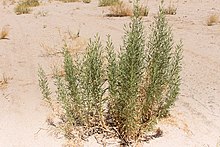Pechuel-loeschea, (common names; stinkbush,[2] sweatbush,[3] or bitterbos,[2][4]) is a monotypic genus of African plants in the elecampane tribe within the sunflower family, and named after the German plant collector and geographer Eduard Pechuël-Loesche (1840-1913).[5]
| Pechuel-loeschea | |
|---|---|

| |
| Scientific classification | |
| Kingdom: | Plantae |
| Clade: | Tracheophytes |
| Clade: | Angiosperms |
| Clade: | Eudicots |
| Clade: | Asterids |
| Order: | Asterales |
| Family: | Asteraceae |
| Subfamily: | Asteroideae |
| Tribe: | Inuleae |
| Genus: | Pechuel-loeschea O.Hoffm. |
| Species: | P. leubnitziae
|
| Binomial name | |
| Pechuel-loeschea leubnitziae | |
| Synonyms[1] | |
| |
The only known species is Pechuel-loeschea leubnitziae,[6][7] (or 'wild sage'[3][8]) which is native to Angola, Botswana, Eswatini, Mozambique, Namibia, Zimbabwe and the Cape Provinces and the Northern Provinces, (in South Africa).[9] The Latin specific epithet of leubnitziae refers to Leubnitzia, the maiden name of Pechuel-Loesche's wife.[3]
Description edit
Strongly aromatic shrubby perennial herb. It grows up to 1.3 m (4 ft 3 in) tall. Most parts are densely grey-velvety and with short glandular hairs. It has alternately arranged leaves, which are (sub)sessile (without a leaf stalk). They are narrowly obovate-elliptic in shape and about 4.5 cm (2 in) long and 0.7 cm wide. They are velvety-grey on both leaf surfaces with a midrib prominent also on both surfaces. The margin is entire (smooth). It blooms between March and July. It has a capitula (a dense cluster of sessile or subsessile flowers) which are terminal (at the end) of 1-3 in the leaf axils. They more or less funnel-shaped and up to 1.3 cm long. The involucral scales (surround the flower head) are greyish glandular and hairy. The florets are purple with the central ray florets absent.[3]
Habitat edit
It is found growing in alkaline and sandy soils in dry wooded grassland or open woodland. It is often found in large amount growing along roadsides and disturbed areas.[3]
References edit
- ^ Flann, C (ed) 2009+ Global Compositae Checklist
- ^ a b Umberto Quattrocchi CRC World Dictionary of Plant Names: Common Names, Scientific Names, Eponyms ... (1999), p. 1984, at Google Books
- ^ a b c d e "Flora of Zimbabwe: Species information: Pechuel-Loeschea leubnitziae". www.zimbabweflora.co.zw. Retrieved 9 November 2021.
- ^ Patricia Craven and Christine Marais Namib Flora: Swakopmund to the Giant Welwitschia Via Goanikontes (1986), p. 58, at Google Books
- ^ Burkhardt, Lotte (2018). Verzeichnis eponymischer Pflanzennamen – Erweiterte Edition [Index of Eponymic Plant Names – Extended Edition] (pdf) (in German). Berlin: Botanic Garden and Botanical Museum, Freie Universität Berlin. doi:10.3372/epolist2018. ISBN 978-3-946292-26-5. Retrieved 1 January 2021.
- ^ "Pechuel-Loeschea | Species Dictionary | Southern Africa | iSpot Nature". www.ispotnature.org. Retrieved 2017-08-16.
- ^ Gibbs Russell, G. E., W. G. M. Welman, E. Retief, K. L. Immelman, G. Germishuizen, B. J. Pienaar, M. Van Wyk & A. Nicholas. 1987. List of species of southern African plants. Memoirs of the Botanical Survey of South Africa 2(1–2): 1–152(pt. 1), 1–270(pt. 2).
- ^ Tedder, Michelle; Morris, Craig; Kirkman, Kevin P.; Trollope, Westleigh Matthew; Bonyongo, Mpaphi Casper (December 2012). "The influence of Pechuel-Loeschea leubnitziae (wild sage) on grass sward and soil seed bank composition". African Journal of Range and Forage Science. 29 (3): 101–107.
- ^ "Pechuel-loeschea O.Hoffm. | Plants of the World Online | Kew Science". Plants of the World Online. Retrieved 9 November 2021.